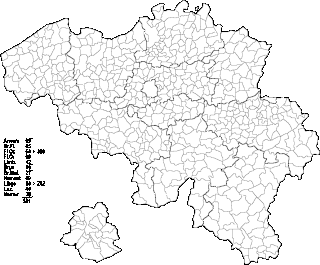
A municipality is usually a single administrative division having corporate status and powers of self-government or jurisdiction as granted by national and regional laws to which it is subordinate. It is to be distinguished (usually) from the county, which may encompass rural territory or numerous small communities such as towns, villages and hamlets.
In many countries, a mayor is the highest-ranking official in a municipal government such as that of a city or a town.

Belgium comprises 581 municipalities grouped into five provinces in each of two regions and into a third region, the Brussels-Capital Region, comprising 19 municipalities that do not belong to a province. In most cases, the municipalities are the smallest administrative subdivisions of Belgium, but in municipalities with more than 100,000 inhabitants, on the initiative of the local council, sub-municipal administrative entities with elected councils may be created. As such, only Antwerp, having over 500,000 inhabitants, became subdivided into nine districts. The Belgian arrondissements, an administrative level between province and municipality, or the lowest judicial level, are in English sometimes called districts as well.

The municipalities of Brazil are administrative divisions of the Brazilian states. At present, Brazil has 5,570 municipalities, making the average municipality population 34,361. The average state in Brazil has 214 municipalities. Roraima is the least subdivided state, with 15 municipalities, while Minas Gerais is the most subdivided state, with 853.

A municipality is a local government unit (LGU) in the Philippines. A municipality is also usually called town in its archaic term, since municipalities have the functions of a town since its inception. They are distinct from cities, which are a different category of local government unit. Provinces of the Philippines are divided into cities and municipalities, which in turn, are divided into barangays, formerly barrios. As of March 31, 2017, there are 1,489 municipalities across the country..
A rural municipality, often abbreviated RM, is a type of municipal status in the Canadian provinces of Manitoba, Saskatchewan, and Prince Edward Island. In other provinces, such as Alberta and Nova Scotia, the term refers to municipal districts that are not explicitly urban, rather than being a distinct type of municipality.
An incorporated town is a town that is a municipal corporation.
Municipalities are the second-level administrative divisions of Mexico, where the first-level administrative division is the state. As of the establishment of two new municipalities in Chiapas in September 2017, there are 2,448 municipalities in Mexico, not including the 16 delegaciones of Mexico City. The internal political organization and their responsibilities are outlined in the 115th article of the 1917 Constitution and detailed in the constitutions of the states to which they belong.
A municipal council is the legislative body of a municipality such as a city council or a town council.
Municipal associations are statutory corporations or public bodies created by statute in the German federal states of Bavaria, Saxony, Thuringia, and Schleswig-Holstein. In Baden-Württemberg the term stipulated municipal association is used.













